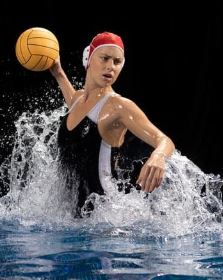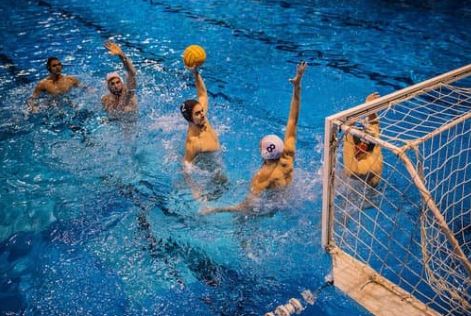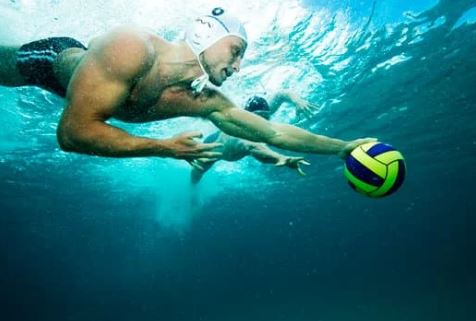Goggles in Water Polo: 2 Reasons You Should Refrain From it!

Water polo is not an easy sport. It requires body contact as well as high physical ability. Apart from the equipment used for swimming, water polo players need two additional things. Can you guess what those are? Yes, you guessed it right! The goals and the ball to play the game with. Now, are all the requirements the same as that of swimming.? The answer is No!! Goggles in water polo are strictly not allowed.
There are two primary reasons why players are not allowed to wear goggles in water polo. The first reason is to avoid any serious injury to the eyes. And the second reason is to prevent giving the opponent chance to pull it off and disorient the opposing team’s players.
Contents
The reasons for players not wearing goggles in water polo

We don’t know how many of you already know this, but water polo is considered one of the most violent sports in human history. The primary reason behind the violence is the close body contact of the players, both with their teammates and their opponents. The injury is unintentional primarily when it is due to a team member. However, when an opponent injures a player, it is often seen as an act to deviate the player from performing well in the game.
All these reasons sum up to answer why the uniform of polo players is kept at a minimum. The ground for the players not wearing goggles in water polo is also to reduce the area for water resistance that might hinder their movement and slow them down in the game.
Choosing not to wear goggles in water polo has other reasons apart from preventing injury. You might often find players wearing goggles in water polo during the practice session. But that is strictly not permitted in the games or matches. The goggles can even become foggy and affect the players’ “peripheral vision.” This is one of the most evident reasons for players avoiding goggles in water polo.
Two primary reasons to ban goggles in water polo

You might have seen the players taking part in FINA, do not wear goggles in water polo matches. Here are the two obvious reasons behind the banning of the goggles by the authority.
The Opponents
Water polo is a very violent game, and thus the players of the opposing team would do anything to get the “upper hand.”
Let us consider a situation where a player chooses to wear goggles in water polo during a practice match. Now, a player from the opposing team grabs the goggles and pulls them. What do you think might happen?
Firstly, the opponent player gets an extra advantage to get a surface to hold on to in the game. Any player or team does not want this. The best interest in this sport is to keep the advantages of the opposing team as low as possible.
Secondly, if any player pulls the goggles of another player, there is a very high chance of the player getting hurt by it when the goggles retrace back. This is not wanted by any player, as this can divert the player from their aim and significantly affect the performance.
Prevent injury
The swimming goggles we are talking about here are made mainly for swimming purposes that are not involved any body contact. But water polo is different. It requires one to defeat the opponent and get hold of the ball to score. So often, the players resort to various violent measures to achieve their goals.
The goggles in water polo are the same as that worn by swimmers, and it is made of hard plastic. During the game, if the player gets hit in the goggles by the head of another player, the injury becomes severe. If they are hit in the goggles, there is a high chance that it gets pressed into the eye sockets causing severe pain.
Also, this cannot be said to be intentional, as water polo is a contact sport. Any interaction with the goggles in water polo could injure the player wearing them.
If you have never seen water polo matches, you might not know why we are telling this to be a violent game. Physical contact is happening among the players, not just above water but underwater. Since this is a highly physically contacted game, it is best advised to keep the equipment to a minimum to reduce the chances of injury.
The “risk to reward” ratio is shallow; as a result, the player often refrains from wearing goggles in water polo. Even players who used to wear goggles in water polo had to stop wearing them within a short period due to this increased chances of getting hurt.
Exceptional Situations

Let us take into consideration our locality, maybe our class or office. How many people around us wear glasses or use contact lenses? Most of them are right! And kids getting glasses from a very young age is increasing day by day. So what should a water polo player do who wears glasses or has poor vision?
Having a clear vision is extremely necessary for sports like water polo. One needs to keep track of their teammate, understand the ball’s trajectory, and know the direction inside the pool. So can a player with poor vision not allow to wear goggles in water polo?
Yes, they are!! There are specially made glasses for these players. They are 100% custom-made, and they have to be prescribed by the doctor. However, regardless of a medical document, whether a player can wear goggles in water polo is entirely dependent on the referee. Although most of the time, if enough documentation is there from a registered medical practitioner, the player is allowed to wear goggles in water polo matches.
Frequently asked questions (FAQs)
Can water polo players wear contact lenses?
Yes, players are allowed to wear contact lenses in matches, but that remains at the referee’s discretion again.
Why are the helmets in this sport used to cover the ears?
Since water polo is a highly physical contact game, players are given helmets that cover the ears to prevent any injury by the ball during a match.
What do the male water polo players wear?
The male players wear swimming briefs or trunks of the color of the respective teams they are playing for.




